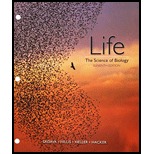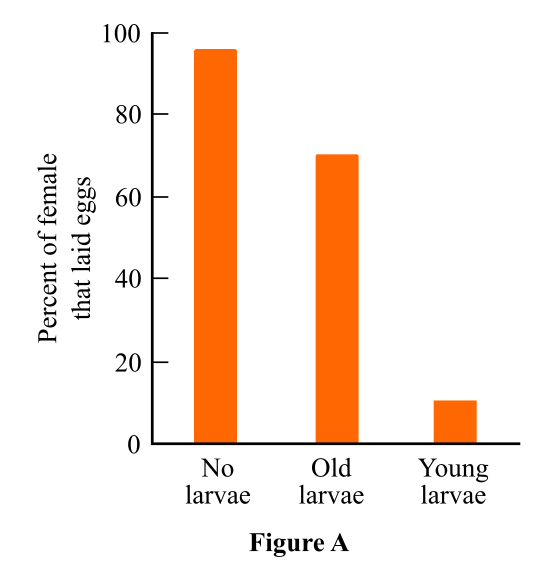
Concept explainers
To review:
The results given in graph A for the energy trade-offs of female burying beetles, which help them to maximize the fitness from an evolutionary point of view.
Given:
Figure A shows the percent of females that laid eggs when they were exposed to various conditions.

Introduction:
In the given experiment, the beetles were exposed to three conditions, which were used to determine its energy investment in brooding and reproduction. In the first treatment, the female beetle was provided with a male partner. The larvae were removed immediately after the egg was laid. The couple was provided with a fresh carcass. In the second treatment, the couple was left with only 10 larvae and a new carcass was provided. In the third treatment, the couple was provided with a new carcass when it had already cared for their hatchlings for 4 days.
Explanation of Solution
Male and female burying beetles meet at the new animal carcass in order to reproduce and feed its offspring by using new carcass as a food source. Parental care and mating do not occur at the same time that is they use energy wisely. After mating, the female beetles produce fertilized eggs on the carcass and both parents feed the new hatchlings for few days. Thus, at the time of parental care, they do not involve or spend energy to reproduce another set of offspring.
The females in the no larvae group are most productive where 90% of the females laid eggs and in the old larvae group, 70% of the females laid eggs. While only 10% of the females in the young larvae group laid eggs. This is because females in the old and no larvae groups preferred mating to produce a new set of offspring as they do not have to spend energy in feeding their offspring.
The females in the young larvae group have to take care of 10 young larvae present in the carcass by feeding and protecting them. New hatchlings can feed themselves after 4 days of parental care. The energy requirements for reproduction and parental care shaped the behavior of beetles to use energy-trade off in order to maximize the fitness.
Thus, the female burying beetles reproduce and provide parental care to its offspring by using energy trade-offs, which directly maximize its fitness as its genes are passed on to its generations successfully.
Want to see more full solutions like this?
Chapter 52 Solutions
LIFE: THE SCIENCE OF BIOLOGY
- 22. Which of the following mutant proteins is expected to have a dominant negative effect when over- expressed in normal cells? a. mutant PI3-kinase that lacks the SH2 domain but retains the kinase function b. mutant Grb2 protein that cannot bind to RTK c. mutant RTK that lacks the extracellular domain d. mutant PDK that has the PH domain but lost the kinase function e. all of the abovearrow_forwardWhat is the label ?arrow_forwardCan you described the image? Can you explain the question as well their answer and how to get to an answer to an problem like this?arrow_forward
- Describe the principle of homeostasis.arrow_forwardExplain how the hormones of the glands listed below travel around the body to target organs and tissues : Pituitary gland Hypothalamus Thyroid Parathyroid Adrenal Pineal Pancreas(islets of langerhans) Gonads (testes and ovaries) Placentaarrow_forwardWhat are the functions of the hormones produced in the glands listed below: Pituitary gland Hypothalamus Thyroid Parathyroid Adrenal Pineal Pancreas(islets of langerhans) Gonads (testes and ovaries) Placentaarrow_forward
- Describe the hormones produced in the glands listed below: Pituitary gland Hypothalamus Thyroid Parathyroid Adrenal Pineal Pancreas(islets of langerhans) Gonads (testes and ovaries) Placentaarrow_forwardPlease help me calculate drug dosage from the following information: Patient weight: 35 pounds, so 15.9 kilograms (got this by dividing 35 pounds by 2.2 kilograms) Drug dose: 0.05mg/kg Drug concentration: 2mg/mLarrow_forwardA 25-year-old woman presents to the emergency department with a 2-day history of fever, chills, severe headache, and confusion. She recently returned from a trip to sub-Saharan Africa, where she did not take malaria prophylaxis. On examination, she is febrile (39.8°C/103.6°F) and hypotensive. Laboratory studies reveal hemoglobin of 8.0 g/dL, platelet count of 50,000/μL, and evidence of hemoglobinuria. A peripheral blood smear shows ring forms and banana-shaped gametocytes. Which of the following Plasmodium species is most likely responsible for her severe symptoms? A. Plasmodium vivax B. Plasmodium ovale C. Plasmodium malariae D. Plasmodium falciparumarrow_forward
 Biology (MindTap Course List)BiologyISBN:9781337392938Author:Eldra Solomon, Charles Martin, Diana W. Martin, Linda R. BergPublisher:Cengage Learning
Biology (MindTap Course List)BiologyISBN:9781337392938Author:Eldra Solomon, Charles Martin, Diana W. Martin, Linda R. BergPublisher:Cengage Learning Biology: The Unity and Diversity of Life (MindTap...BiologyISBN:9781305073951Author:Cecie Starr, Ralph Taggart, Christine Evers, Lisa StarrPublisher:Cengage Learning
Biology: The Unity and Diversity of Life (MindTap...BiologyISBN:9781305073951Author:Cecie Starr, Ralph Taggart, Christine Evers, Lisa StarrPublisher:Cengage Learning
 Biology Today and Tomorrow without Physiology (Mi...BiologyISBN:9781305117396Author:Cecie Starr, Christine Evers, Lisa StarrPublisher:Cengage Learning
Biology Today and Tomorrow without Physiology (Mi...BiologyISBN:9781305117396Author:Cecie Starr, Christine Evers, Lisa StarrPublisher:Cengage Learning Biology: The Dynamic Science (MindTap Course List)BiologyISBN:9781305389892Author:Peter J. Russell, Paul E. Hertz, Beverly McMillanPublisher:Cengage Learning
Biology: The Dynamic Science (MindTap Course List)BiologyISBN:9781305389892Author:Peter J. Russell, Paul E. Hertz, Beverly McMillanPublisher:Cengage Learning Biology: The Unity and Diversity of Life (MindTap...BiologyISBN:9781337408332Author:Cecie Starr, Ralph Taggart, Christine Evers, Lisa StarrPublisher:Cengage Learning
Biology: The Unity and Diversity of Life (MindTap...BiologyISBN:9781337408332Author:Cecie Starr, Ralph Taggart, Christine Evers, Lisa StarrPublisher:Cengage Learning





